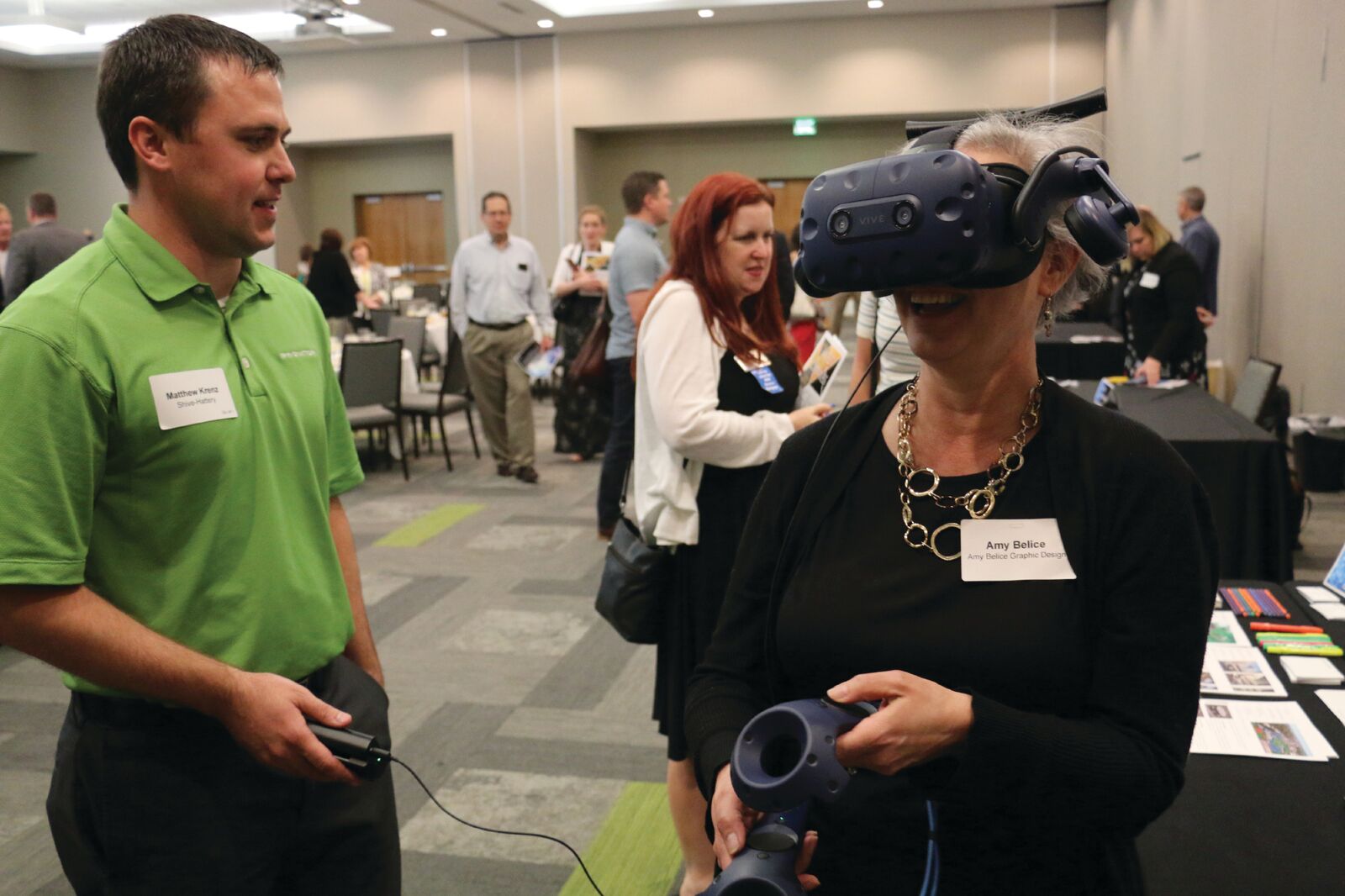
Shive-Hattery’s Matthew Krenz takes attendee Amy Belice through a virtual demonstration world at the CBJ’s Tech Untangled event. PHOTO ADAM MOORE
By Dave DeWitte
[email protected]
Technology is constantly advancing, offering new opportunities for those who grasp its potential.
At the CBJ’s Tech Untangled event, held May 16 at the Hotel at Kirkwood, local experts presented TED-style talks on five emerging technologies that have the potential to impact everyone in business, including blockchain, automated vehicle tech, 5G networks, virtual reality and edtech.
The following are condensed recaps of what speakers from ACT Inc., the National Advanced Driving Simulator, RSM US LLP, Shive-Hattery and U.S. Cellular had to say about these emerging technologies and what to expect in the coming years.
Tech Untangled was presented by ACT Inc., with support from Collins Community Credit Union and RSM US LLP.
Edtech on the rise
ACT in Iowa City continues to transform from a testing company to a tech company, offering its RAD (Recommendations and Diagnostics) Engine as an example of its future.
“To really improve education, learning needs to be data-driven, and to use data you need technology,” ACT CEO Marten Roorda said at the opening of Tech Untangled.
As students take tests on the company’s free ACT Academy online learning platform, RAD continuously tracks their mastery of different academic skills. It uses the results to recommend new resources, such as lessons, videos and games that address skills the student still needs to master, and delivers them in real time.
RAD was developed by ACT’s innovation unit, ACTNext, using artificial intelligence-based algorithms fused with psychometric theory, and has already been delivered to courseware designers around the world through the company’s partnership with Smart Sparrow.
Mr. Roorda said technology is enabling instructors to personalize lesson plans for entire classrooms, something that would have been impossible for teachers to do just a few years ago.
“Now education technology is beginning a real disruption and evolution in education,” Mr. Roorda said. “There’s a new ecosystem for learning coming into existence.”
Mary Michael Pontzer, vice president of product at ACT, said technology is disupting the traditional linear pattern of classroom learning and creating immersive experiences.
On a visit to Smart Sparrow, she described using an Oculus headset to try out a virtual reality learning environment that took her inside a human cell.
“It goes beyond hands-on learning – it’s a full-body experience,” she said.
Test-driving automated vehicles
A short stretch of Ely Road in Linn County was closed briefly this spring so it could be used to test automated vehicle technology – the latest sign that the age of automated and autonomous transportation is here.
High-definition digital mapping of I-380 down to the centimeter has been completed between Cedar Rapids and Iowa City, and an Iowa Department of Transportation-led project is providing thousands of miles of digital maps to autonomous vehicle companies interested in conducting R&D in the state.
Daniel McGehee, director of the National Advanced Driving Simulator at the University of Iowa, has been a key collaborator in the state’s efforts to attract advanced driving technology companies to the state. Speaking at Tech Untangled, he said that the math behind collision avoidance technology is complex, but not particularly complicated to understand.
An automated vehicle is equipped with radars, cameras and sensors that detect objects in a bow-shaped field around it and feed the information into a computer vision system. When the sensors detect a vehicle, person, animal or other object, it generates rectangles to define the boundaries of the objects. The computer measures the size of those “targets” as the distance between the vehicle and the object narrows. As the size of the box looms larger, algorithms calculate the danger of a collision based on the speed and direction of the vehicle, and trigger an alert to the driver or automatically apply the brakes.
A widespread misconception is that fully autonomous vehicles are just over the horizon. Because of liability issues, Mr. McGehee said, “drivers will be still very much part of driving for years to come.”
While technology will reduce the danger and workload for drivers, Mr. McGehee said it’s more likely we’ll see technology like interstate highway truck convoys connected through technology, with one driver in the lead vehicle. He expects some of the first autonomous vehicles to be small buses with about a dozen passengers that will travel through congested areas.
The blockchain revolution
It may have been overhyped, but blockchain technology is real and coming on in a very big way, according to Bennett Moore of RSM US LLP.
Mr. Moore said blockchain is, at its most basic, a “distributed ledger” in which transactions are recorded, distributed to the parties involved and confirmed in a “pseudo-anonymous” manner. It is an “append only” database in which information, once entered and accepted by the parties, cannot be changed.
Blockchain isn’t so much a beneficial technology on its own, as it is an infrastructure that can be used to efficiently leverage other innovations such as 3-D printing, the Internet of Things and big data, Mr. Moore said.
Although it can be used in many types of transactions, one of the high demand business applications for blockchain is for streamlining international trade finance.
In that scenario, the importer’s bank issues a letter of credit to an exporter promising to pay when documents such as a bill of lading are provided by the exporter, showing that the goods have been loaded onto a vessel bound for their destination. Each side uses their own set of spreadsheets to record documents in each step of the process.
Using blockchain can eliminate the need for multiple copies of documents and compress the time required for transactions, Mr. Moore said. The technology can even incorporate data from smart sensors to automatically make price adjustments in a trade settlement if, for instance, the temperature of a shipment in transit exceeds the contractually allowed temperature range.
5G to power the future
The shift from 4G LTE to 5G cellular networks is coming to Eastern Iowa, bringing with it high bandwidth and low latency connections that will power an abundance of new technologies.
U.S. Cellular plans to roll out its 5G network in Iowa by the end of January 2020, according to Bill Borkowicz, the company’s director of sales for data and software solutions.
“There are really three capabilities 5G will deliver,” Mr. Borkowicz said:
- Enhanced Mobile Broadband, which will power uses requiring high data rates across a wide area coverage, such as self-driving aerial taxis, intelligent apps to support and assist visitors at large events and child location monitoring
- Massive Machine Type Communications, which will use 5G to support the Internet of Things – armies of devices such as sensors, thermostats and fire alarms that can be controlled and monitored via the internet
- Ultra Reliable Low Latency Communications, which will use 5G to meet mission-critical application requirements that demand low latency, such as performing remote robotic surgery or transmitting data to and from autonomous vehicles.
Mr. Borkowicz also sees a broadband explosion arriving in the form of Long Range Low Power Wide Area Networks, which he described as “Wi-Fi on steroids.” It’s a non-cellular technology that doesn’t require licensed bandwidth, which U.S. Cellular plans to offer through partner IoT America to provide broadband connections for things like trash bin monitoring in smart cities and soil moisture monitoring in smart agriculture.
VR and AR offer new avenues for design
Virtual reality is transforming the architecture, engineering and construction industries, drawing inspiration from the world of gaming, according to Process Designer Matthew Krenz and Design Technology Lead Garret Meierbachtol of Shive-Hattery, the Cedar Rapids-based engineering and design firm.
“We were able to take our models and put them in gaming environments and create interactive experiences for our clients and designers,” Mr. Meierbachtol said.
Having a virtual reality environment “gives us that sense of immersion,” he added. “When you put yourself into your design at that level, you’re able to make more informed decisions. It’s called empathetic design, and it’s how you can put yourself in the shoes of someone who is hearing impaired, or has limited sight.”
Mr. Krenz said Shive-Hattery is also using augmented reality, somewhat like Snapchat’s ability to superimpose objects over photographs. It allows the company’s architects and engineers to take their models out into the real world, plot them in place and see how they react.
“We can take blueprints and drawings and put them on the screen,” Mr. Meierbachtol said, calling it a useful tool for showing “as-builts,” or images of how a completed project looks with final revisions.
Such augmented reality technologies are also arriving in the area of remote help desk support and technical support for complex repair and assembly tasks, he added. A smartphone camera can show the help desk what the user is seeing so that they can more accurately direct the repair or assembly task. CBJ




